What We’re Reading: March 2nd
This week’s edition is guest edited by Arif Ashraf (@aribidopsis), a graduate student of United Graduate School of Agricultural Sciences, Iwate University, Japan and Graduate student ambassador of American Society of Plant Biologists (ASPB). His research interest is understanding the hormonal interplay in primary root development of Arabidopsis thaliana. He blogs about plant science at www.aribidopsis.com.
Review: The pivotal role of ethylene in plant growth
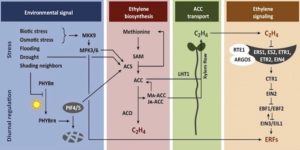 Phytohormones, their ratios and gradients, regulate plant development to allow them to adapt to environment changes. Ethylene, one such hormone, is produced in response to a multitude of stresses: biotic, osmotic, flooding, drought or even shading by neighbors. Dubois et al. report in this review how ethylene specifically regulates plant growth, mainly focussing in leaves. Normally, plants overproducing ethylene have a dwarf phenotype. However, it has been reported that low concentrations of ethylene promote growth response in young leaves. Ultimately, the data obtained on ethylene-mediated growth processes has proven to be effectively translatable from model plants into crops, like Oryza sativa and Solanum lycopersicum, to improve plant growth and stress tolerance. (Summary by Isabel Mendoza) Trends Plant Sci: 10.1016/j.tplants.2018.01.003
Phytohormones, their ratios and gradients, regulate plant development to allow them to adapt to environment changes. Ethylene, one such hormone, is produced in response to a multitude of stresses: biotic, osmotic, flooding, drought or even shading by neighbors. Dubois et al. report in this review how ethylene specifically regulates plant growth, mainly focussing in leaves. Normally, plants overproducing ethylene have a dwarf phenotype. However, it has been reported that low concentrations of ethylene promote growth response in young leaves. Ultimately, the data obtained on ethylene-mediated growth processes has proven to be effectively translatable from model plants into crops, like Oryza sativa and Solanum lycopersicum, to improve plant growth and stress tolerance. (Summary by Isabel Mendoza) Trends Plant Sci: 10.1016/j.tplants.2018.01.003
Updates on Resources, Software Tools, and Databases for Plant Proteomics in 2016–2017 ($)
 Proteomics, like metabolomics research, depends on the mass-spectrometry tools. Data processing, protein annotation, statistical and data analysis, as well as visualization are often the hurdles in obtaining meaningful biological insights from high throughput datasets. To this end, the author has summarized all open source community resources, software tools, and databases that surfaced in 2016-2017 and are useful for the plant proteomics community. Given that > 900 papers were published in plant proteomics in 2016 alone, better analysis tools are needed more than ever. In addition to compiling > 50 software tools for the plant proteomics community, the review describes publication trends in proteomics, a time-line showing important events in plant proteomics research, and a generic workflow for plant proteomics from sample to data. The review also includes a table categorizing the tools used for data preprocessing and analysis, statistical analysis, peptide identification, databases and spectral libraries, data visualization and interpretation. (Summary by Biswapriya Misra) Electrophoresis: 10.1002/elps.201700401
Proteomics, like metabolomics research, depends on the mass-spectrometry tools. Data processing, protein annotation, statistical and data analysis, as well as visualization are often the hurdles in obtaining meaningful biological insights from high throughput datasets. To this end, the author has summarized all open source community resources, software tools, and databases that surfaced in 2016-2017 and are useful for the plant proteomics community. Given that > 900 papers were published in plant proteomics in 2016 alone, better analysis tools are needed more than ever. In addition to compiling > 50 software tools for the plant proteomics community, the review describes publication trends in proteomics, a time-line showing important events in plant proteomics research, and a generic workflow for plant proteomics from sample to data. The review also includes a table categorizing the tools used for data preprocessing and analysis, statistical analysis, peptide identification, databases and spectral libraries, data visualization and interpretation. (Summary by Biswapriya Misra) Electrophoresis: 10.1002/elps.201700401
Review: New tools and resources in metabolomics: 2016–2017 ($)
 Metabolomics, like the other high throughput omics platforms, provides a snapshot of metabolites in response to a condition or in a cell, tissue, organ, or entire organism. In this review, the author has cataloged all relevant tools, databases and softwares that were published in 2016-2017 for the metabolomics community. The review summarizes > 85 different tools developed during the year for processing metabolomics data from specific analytical platforms, for untargeted analysis, for preprocessing and quality control measures, annotation, and several multifunctional and miscellaneous tools. (Summary by Biswapriya Misra) Electrophoresis: 10.1002/elps.201700441
Metabolomics, like the other high throughput omics platforms, provides a snapshot of metabolites in response to a condition or in a cell, tissue, organ, or entire organism. In this review, the author has cataloged all relevant tools, databases and softwares that were published in 2016-2017 for the metabolomics community. The review summarizes > 85 different tools developed during the year for processing metabolomics data from specific analytical platforms, for untargeted analysis, for preprocessing and quality control measures, annotation, and several multifunctional and miscellaneous tools. (Summary by Biswapriya Misra) Electrophoresis: 10.1002/elps.201700441
A phosphoinositide map at the shoot apical meristem in Arabidopsis thaliana
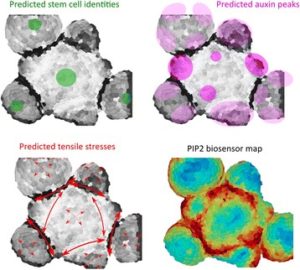 Plasma membrane lipids including phosphatidylinositol phosphates (PIPs) are often depicted as forming a featureless plane that serves mainly as a barrier, but in reality they show considerable spatial diversity. PIPs contribute to anchoring and positioning proteins and protein networks, so there is much to be learned by mapping their dynamic distributions. Stanislas et al. used fluorescent proteins that bind to specific PIP forms including PI4P and PI(4,5)P2 to map PIP dynamics at the shoot apical meristem. The authors observed a relatively low abundance of PI4P and PI(4,5)P2 in the central zone and enhanced levels in the organ boundary zones. To investigate a functional role for this pattern, the authors examined both PIP and meristem mutants. Their results suggest a positive correlation between PI(4,5)P2, cortical microtubules, and mechanical stress at the SAM. This study highlights the potential role for PIPs as mediators of patterning through interactions with the cytoskeleton and/or mechanosensors, as has been suggested in animal cells. (Summary by Mary Williams) BMC Biol. 10.1186/s12915-018-0490-y
Plasma membrane lipids including phosphatidylinositol phosphates (PIPs) are often depicted as forming a featureless plane that serves mainly as a barrier, but in reality they show considerable spatial diversity. PIPs contribute to anchoring and positioning proteins and protein networks, so there is much to be learned by mapping their dynamic distributions. Stanislas et al. used fluorescent proteins that bind to specific PIP forms including PI4P and PI(4,5)P2 to map PIP dynamics at the shoot apical meristem. The authors observed a relatively low abundance of PI4P and PI(4,5)P2 in the central zone and enhanced levels in the organ boundary zones. To investigate a functional role for this pattern, the authors examined both PIP and meristem mutants. Their results suggest a positive correlation between PI(4,5)P2, cortical microtubules, and mechanical stress at the SAM. This study highlights the potential role for PIPs as mediators of patterning through interactions with the cytoskeleton and/or mechanosensors, as has been suggested in animal cells. (Summary by Mary Williams) BMC Biol. 10.1186/s12915-018-0490-y
LPCAT1 controls phosphate homeostasis in a zinc-dependent manner
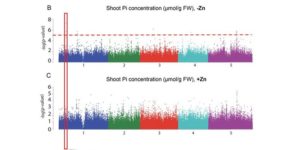 Phosphate availability is one of the main limiting factors for plant growth. Similarly, zinc deficiency represents a threat for agriculture and children nutrition and there is a complex interaction between phosphate and zinc nutrition. Kisko et al. investigate the interaction of phosphate and zinc nutrition by using a panel of 223 Arabidopsis accessions and quantifying shoot phosphate concentration. Through GWAS, they identify a LysoPhosphatidylCholine AcylTransferase (LPCAT1) that regulated shoot phosphate level under zinc deficiency, the level of the phosphate transporter PHT1;1 and the balance among phospholipids. Within the promoter of the gene, they show a new binding site for a key transcription factor involved in zinc starvation signaling, bZIP23, and a different binding affinity among accessions showing different shoot phosphate concentrations. (Summary by Marco Giovannetti) eLife: 10.7554/eLife.32077.001
Phosphate availability is one of the main limiting factors for plant growth. Similarly, zinc deficiency represents a threat for agriculture and children nutrition and there is a complex interaction between phosphate and zinc nutrition. Kisko et al. investigate the interaction of phosphate and zinc nutrition by using a panel of 223 Arabidopsis accessions and quantifying shoot phosphate concentration. Through GWAS, they identify a LysoPhosphatidylCholine AcylTransferase (LPCAT1) that regulated shoot phosphate level under zinc deficiency, the level of the phosphate transporter PHT1;1 and the balance among phospholipids. Within the promoter of the gene, they show a new binding site for a key transcription factor involved in zinc starvation signaling, bZIP23, and a different binding affinity among accessions showing different shoot phosphate concentrations. (Summary by Marco Giovannetti) eLife: 10.7554/eLife.32077.001
Ethylene receptors signal via a noncanonical pathway to regulate abscisic acid responses ($)
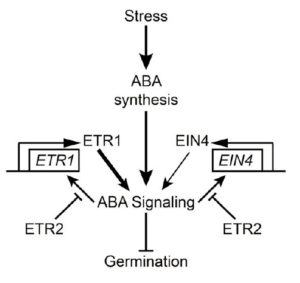 The two-carbon containing gaseous hydrocarbon, ethylene, is one of the most important phytohormones. It is perceived by a set of receptors (ETR1, ETR2, ERS, ERS2, EIN4). Bakshi et al. found that ETR1 (etr1-6) and ETR2 (etr2-3) mutants have opposite effects on seed germination in the presence of NaCl, KCl, ethanol, CuSO4, and ZnSO4. In the presence of the ABA biosynthesis inhibitor norflurazon (NF), the germination effect is abolished, which suggests that the process is ABA-dependent. Additionally, the authors found that receiver domain of the receptor is critical for the effect on seed germination. Deletion of receiver domains (etr1-6 etr2-3 ein4-4) causes wild-type like seed germination. This receiver domain-dependent seed germination process is independent of the immediate downstream signaling molecule, CTR1. Interestingly, ABA alters the transcript levels of ETR1, ETR2 and EIN4 but not ERS1 and ERS2. By using the receiver domain for a protein-protein interaction study, the authors identified three proteins (LEB, RD21A, DI19). Mutants of these three proteins have reduced ABA responsiveness and faster seed germination like the etr1-6 mutant. (Summary by Arif Ashraf) Plant Physiol. 10.1104/pp.17.01321
The two-carbon containing gaseous hydrocarbon, ethylene, is one of the most important phytohormones. It is perceived by a set of receptors (ETR1, ETR2, ERS, ERS2, EIN4). Bakshi et al. found that ETR1 (etr1-6) and ETR2 (etr2-3) mutants have opposite effects on seed germination in the presence of NaCl, KCl, ethanol, CuSO4, and ZnSO4. In the presence of the ABA biosynthesis inhibitor norflurazon (NF), the germination effect is abolished, which suggests that the process is ABA-dependent. Additionally, the authors found that receiver domain of the receptor is critical for the effect on seed germination. Deletion of receiver domains (etr1-6 etr2-3 ein4-4) causes wild-type like seed germination. This receiver domain-dependent seed germination process is independent of the immediate downstream signaling molecule, CTR1. Interestingly, ABA alters the transcript levels of ETR1, ETR2 and EIN4 but not ERS1 and ERS2. By using the receiver domain for a protein-protein interaction study, the authors identified three proteins (LEB, RD21A, DI19). Mutants of these three proteins have reduced ABA responsiveness and faster seed germination like the etr1-6 mutant. (Summary by Arif Ashraf) Plant Physiol. 10.1104/pp.17.01321
Nitrate modulates stem cell dynamics in Arabidopsis meristems through cytokinins ($)
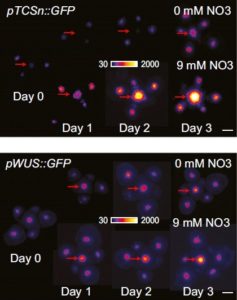 The SAM (Shoot Apical Meristem) generates the cells that make up the shoot. In this paper, Landrein et al. studied how nutrient availability shapes SAM architecture. They showed that SAM size is positively correlated with both pTCSn::GFP (a cytokinin reporter) and pWUS::GFP (a major regulator for stem cell homeostasis) at various soil conditions. Additionally, they found that SAM size correlates with nitrate availability; nitrate modulates SAM homeostasis through IPTs (ISOPENTENYL TRANSFERASE) by modulating the expression of WUSCHEL. This mechanistic explanation from this study can be applied to crop plants to increase food production. (Summary by Arif Ashraf) PNAS: 10.1073/pnas.1718670115
The SAM (Shoot Apical Meristem) generates the cells that make up the shoot. In this paper, Landrein et al. studied how nutrient availability shapes SAM architecture. They showed that SAM size is positively correlated with both pTCSn::GFP (a cytokinin reporter) and pWUS::GFP (a major regulator for stem cell homeostasis) at various soil conditions. Additionally, they found that SAM size correlates with nitrate availability; nitrate modulates SAM homeostasis through IPTs (ISOPENTENYL TRANSFERASE) by modulating the expression of WUSCHEL. This mechanistic explanation from this study can be applied to crop plants to increase food production. (Summary by Arif Ashraf) PNAS: 10.1073/pnas.1718670115
EIN3 and PIF3 form an interdependent module that represses chloroplast development in buried seedlings ($)
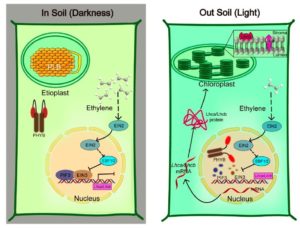 Photosynthesis is the fundamental process for plants to produce food. Beneath the soil there is an impairment of chloroplast development. In this article, Liu et al. identified that mechanical pressure works through the ethylene-responsive transcription factor EIN3, while light signaling is mediated via PIF3. In an interdependent manner, EIN3 and PIF3 inhibit the transcription of LHC (Light Harvesting Complex) genes in the presence of mechanical stress and the absence of light. In contrast, in the absence of mechanical stress and presence of light, EIN3 and PIF3 are degraded, facilitating LHC expression. This study provides a mechanistic model for etioplast and chloroplast development in soil-buried condition and in the presence of light, respectively. (Summary by Arif Ashraf) Plant Cell 10.1105/tpc.17.00508
Photosynthesis is the fundamental process for plants to produce food. Beneath the soil there is an impairment of chloroplast development. In this article, Liu et al. identified that mechanical pressure works through the ethylene-responsive transcription factor EIN3, while light signaling is mediated via PIF3. In an interdependent manner, EIN3 and PIF3 inhibit the transcription of LHC (Light Harvesting Complex) genes in the presence of mechanical stress and the absence of light. In contrast, in the absence of mechanical stress and presence of light, EIN3 and PIF3 are degraded, facilitating LHC expression. This study provides a mechanistic model for etioplast and chloroplast development in soil-buried condition and in the presence of light, respectively. (Summary by Arif Ashraf) Plant Cell 10.1105/tpc.17.00508
BES1 and BZR1 redundantly promote phloem and xylem differentiation ($)
 In vascular development, procambial or cambial cells differentiate into xylem and phloem. In this research article, by using VISUAL (Vascular cell Induction culture System Using Arabidopsis Leaves) system, Saito et al. identified BES1 (BRI1 EMS SUPPRESSOR 1) as one of the components required for xylem differentiation. They found that BES1 also positively regulates phloem differentiation and acts downstream of GSK3 (Glycogen Synthase Kinase 3). In addition, the close homolog of BES1, BZR1, works redundantly in the same developmental pathway. This study shows the involvement of brassinosteroid-signaling transcription factors (BES1, BZR1) as regulators for xylem and phloem cell differentiation from vascular stem cells. (Summary by Arif Ashraf) Plant Cell Physiol. 10.1093/pcp/pcy012
In vascular development, procambial or cambial cells differentiate into xylem and phloem. In this research article, by using VISUAL (Vascular cell Induction culture System Using Arabidopsis Leaves) system, Saito et al. identified BES1 (BRI1 EMS SUPPRESSOR 1) as one of the components required for xylem differentiation. They found that BES1 also positively regulates phloem differentiation and acts downstream of GSK3 (Glycogen Synthase Kinase 3). In addition, the close homolog of BES1, BZR1, works redundantly in the same developmental pathway. This study shows the involvement of brassinosteroid-signaling transcription factors (BES1, BZR1) as regulators for xylem and phloem cell differentiation from vascular stem cells. (Summary by Arif Ashraf) Plant Cell Physiol. 10.1093/pcp/pcy012
CRootBox: a structural – functional modeling framework for root systems
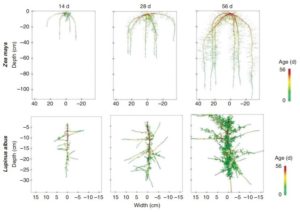 Root architecture is important to understand the response of plants during biotic and abiotic stress conditions. Root growth is mostly under soil, which deprives us of the ability to observe its development and growth pattern. In this paper, Schnepf et al. present CRootBox, a framework developed based on C++ and Python, for root architecture analysis. Users may include CRootBox in their Python code. The authors have tested the efficiency of this framework for individual root growth systems, root growth in containers and field simulated conditions, root growth in static solid conditions, and water uptake by root from soil. This framework will help to decipher unknown facts about root architecture in the future. (Summary by Arif Ashraf) Annals of Botany 10.1093/aob/mcx221
Root architecture is important to understand the response of plants during biotic and abiotic stress conditions. Root growth is mostly under soil, which deprives us of the ability to observe its development and growth pattern. In this paper, Schnepf et al. present CRootBox, a framework developed based on C++ and Python, for root architecture analysis. Users may include CRootBox in their Python code. The authors have tested the efficiency of this framework for individual root growth systems, root growth in containers and field simulated conditions, root growth in static solid conditions, and water uptake by root from soil. This framework will help to decipher unknown facts about root architecture in the future. (Summary by Arif Ashraf) Annals of Botany 10.1093/aob/mcx221
Evolutionary history resolves global organization of root functional traits ($)
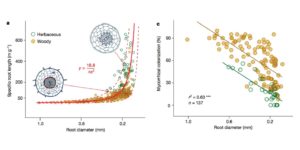 Roots differ in their form and function, as they need to compete for water and nutrients in the wide range of environment. Although we are starting to understand some adaptive aspects of individual root morphology features, the adaptive features of root organization are still poorly understood. Ma and colleagues evaluated the roots of 369 species native to 7 major biomes across 3 continents. The team focused on the plants native to the biomes and evaluated primary root traits related to morphology, physiology and mycorrhizal association. Principle component analysis revealed that traits contributing to the observed variation include root diameter and mycorrhizal symbiosis. Thin-rooted varieties dominated in the biomes with high seasonal variations, where relatively small investment of carbon correspond to exploration of large soil volume for moisture and nutrients, reducing dependence on the mycorrhizal symbiosis. Thick roots were associated with the more stable climates as well as ancient taxonomic groups. The authors hypothesize that thin root species have advantage of adapting their root distribution to seasonal changes in soil resources and inhospitable conditions. (Summary by Magdalena Julkowska) Nature: 10.1038/nature25783
Roots differ in their form and function, as they need to compete for water and nutrients in the wide range of environment. Although we are starting to understand some adaptive aspects of individual root morphology features, the adaptive features of root organization are still poorly understood. Ma and colleagues evaluated the roots of 369 species native to 7 major biomes across 3 continents. The team focused on the plants native to the biomes and evaluated primary root traits related to morphology, physiology and mycorrhizal association. Principle component analysis revealed that traits contributing to the observed variation include root diameter and mycorrhizal symbiosis. Thin-rooted varieties dominated in the biomes with high seasonal variations, where relatively small investment of carbon correspond to exploration of large soil volume for moisture and nutrients, reducing dependence on the mycorrhizal symbiosis. Thick roots were associated with the more stable climates as well as ancient taxonomic groups. The authors hypothesize that thin root species have advantage of adapting their root distribution to seasonal changes in soil resources and inhospitable conditions. (Summary by Magdalena Julkowska) Nature: 10.1038/nature25783



